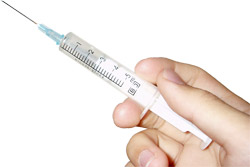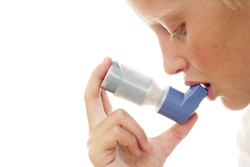- Definition of glucocorticosteroids
- Glucocorticoids for the treatment of respiratory conditions
- How glucocorticosteroids work
- Initiating glucocorticosteroid therapy
Definition of glucocorticosteroids

Several synthetic glucocorticosteroids are also produced as medicines for treatment of inflammatory conditions. Similar to endogenous glucocorticoids, once inhaled, injected or swallowed as medicines, synthetic glucocorticoids enter and circulate in the blood stream. Synthetic glucocorticoids have been developed for the treatment of inflammatory conditions (e.g. asthma, arthritis) and have greater potency than those produced by the body. Glucocorticoids can be used for treatment of asthma, treatment of hayfever as well as treatment of allergy in general. Synthic glucocorticoid medications include:
- Ciclesonide (e.g. Alvesco, Omnaris);
- Dexamethasone (e.g. Decadron, Dexmethsone, DBL Dexamethasone Sodium Phosphate Injection);
- Budesonide (e.g. Pulmicort, Rhinocort, Symbicort);
- Beclomethasone dipropionate (e.g. Beconase, Becotide, Qvar);
- Flunisolide;
- Fluticasone (e.g. Flixonase, Flixotide, Avamys);
- Triamcinolone (e.g. Aristocort, Kenacomb, Kenacort);
- Prednisolone (e.g. Panafcortelone, Predsol, Solone);
- Prednisone (e.g. Panafcort, Predsone, Sone).
Glucocorticoids for the treatment of respiratory conditions
Synthetic glucocorticoids are used in the treatment of a range of inflammatory conditions of the respiratory system including:
- Allergic rhinitis (seasonal rhinitis, or hayfever, and perennial allergic rhinitis);
- Chronic obstructive pulmonary disorder (COPD);
- Asthma;
- Community acquired pneumonia; and
- Non-allergic rhinitis.
 |
For more information about the structure and function of the respiratory system, see Respiratory System. |
How glucocorticosteroids work
The precise ways in which glucocorticosteroids work to reduce inflammation are not fully understood. However, scientific knowledge about their effect upon the human body is increasing. It is known that once glucocorticoids enter the blood stream, they interact with glucocorticosteroid receptors (GRs), which are found in most body cells. The number of GRs in a given cell differs depending on the type of body cell. The concentrations of glucocorticosteroids in the blood influences the extent to which they interact with GRs, as higher concentrations of glucocorticoids cause GRs to become less active and thus reduce interaction between the glucocorticoid and its receptors.
The extent to which glucocorticoids and GRs interact also depends on the type of GR. GRs can be categorised into two functionally different types: alpha and beta. Beta-GRs do not bind to glucocorticoids. Alpha-GRs have the capacity to bind to glucocorticoids which are circulating in the blood. Binding to an alpha-GR causes glucocorticoids to enter the cell in which the GR is located and begin to exert its anti-inflammatory effects within that cell.
Alpha-GRs attract glucocorticoids to the cells and help them enter the cytoplasm of the cell. The cytoplasm is a gel-like substance which holds the components of the cell together and gives the cell its structure. Once a glucocorticoid has entered the cytoplasm, it binds and causes changes to the GR. Binding between the GR and glucocorticoid also localises the action of the glucocorticoid to the target cell; once bound to the GR the glucocorticoid exerts its effects within the cell it has entered, but not on other body cells.

Glucocorticoids reduce the activity of substances which cause inflammatory responses from the immune system. These include some cytokines (proteins which regulate the intensity and duration of immune responses) and chemokines (a specific type of cytokine which attract leukocytes, commonly called white blood cells). Reducing cytokine and chemokine activity in turn reduces the activation of leukocytes. Leukocytes are part of the immune system and are activated to protect the body from potentially dangerous substances, as in an allergic response.
However, the process by which glucocorticoids reduce the activity of substances involved in inflammation, and in turn reduce inflammatory responses, is not fully understood. It appears that many chemicals in the blood and body cells are involved in the chain of events by which glucocorticoids reduce leukocyte activity. These include chemicals which influence the activity of:
- Helper T cells, a type of white blood cell which helps fight infection; and
- IgE: an immunoglobulin which works with the immune system to activate mast cells, (cells which cause inflammation).
In addition, glucocorticoids appear to increase the activity of substances which inhibit inflammatory responses.
Prodrug formulations
Prodrugs are drugs which are not activated until they enter the human body. Once in the body they are metabolised (broken down) into new forms which exert an effect on the body. In the case of glucocorticosteroids this effect is anti-inflammatory. Prodrug formulations of glucocorticosteroids include ciclesonide and prednisolone. They are associated with increased treatment efficacy and reduced side effects.
For example, the prodrug glucocorticoid ciclesonide, is only converted to its metabolically active form when it reaches the site of inflammation. This means it only acts on the inflamed cell, and not other body cells. Onsite activation enables a highly potent effect at the inflamed site (e.g. the nose in allergic rhinitis) with a lower dose than would be needed to exert the same effect if the active substance worked at other body sites. It also reduces the side effects of taking glucocorticoids as they only exert their effects at the inflamed site and not on the entire body.
Initiating glucocorticosteroid therapy
Glucocorticoids are associated with significant side effects, particularly systemic preparations (preparations which exert their effects on the entire body). Limiting side effects by limiting the extent to which glucocorticoids act systemically is an important component of treatment. Inhaled formulations are typically more desirable than systemic formulations because they are delivered directly to the site of inflammation when inhaled through the nose (as in allergic rhinitis) or windpipe (as in asthma). Prodrug formulations are also associated with less systemic absorption because they are only activated at the site of inflammation.
Systemic formulations

Systemic glucocorticoids may be addictive and withdrawal may occur when an individual stops taking the medicine after using systemic glucocorticoids for more than 2 weeks. Other side effects may also occur when an individual takes systemic glucocorticoids, because of their hormone production suppressing effects. Side effects associated with systemic glucocorticoid preparations, which are not associated with inhaled formulas, include:
- Swelling of the face;
- Disorders of the skin and appendages (e.g. fingernails);
- Reduced bone mass due to inhibition of bone formation;
- Growth stunting;
- Cataracts (which are also associated with inhaled therapy when they are taken in high doses);
- Psychiatric disturbances including aggressive behaviour, insomnia and depression;
- Menstrual disorders; and
- Wasting away of muscles at the injection site (when glucocorticoids are injected).
Topical formulations
Topical glucocorticoid formulations were developed to enable high concentrations of glucocorticoids to be established at target sites (e.g. the nose in allergic rhinitis) while limiting the extent to which glucocorticoids circulate through the body as a whole. The proportion of the glucocorticosteroid which acts on targeted cells and that which enters the blood stream and circulates through the body differs between different topical formulations of glucocorticoids. The most desirable formulations are those which:
- Establish high concentrations of glucocorticoid at the target site;
- Have limited concentration in the blood stream and at non-target sites in the body; and
- Are metabolised rapidly, that is, they are broken down and cleared from the body quickly.
Treatment of allergic rhinitis/hayfever
Glucocorticosteroids are used to treat the late phase symptoms of allergic rhinitis/hayfever (those symptoms which occur because the body tries to sustain the allergic response). They are effective in treating individuals with severe symptoms, including those resistant to other treatments such as antihistamines.
Who should not use glucocorticosteroids?

- Glaucoma;
- Herpes keratitis (herpes infection of the eye);
- Diabetes mellitus;
- Psychological instability;
- Advanced osteoporosis;
- Severe hypertension;
- Tuberculosis; and
- Other chronic infections.
They should also be avoided in pregnant women and in children.
Formulations and dosing
Glucocorticosteroids for the treatment of allergic rhinitis/hayfever are available as intranasal sprays, tablets and injections. Tablet and injectable formulations are absorbed systemically and carry a high risk of side effects, thus intranasal sprays are typically recommended.
Intranasal sprays
Intranasal sprays are indicated for the acute and preventative treatment of mild to severe allergic rhinitis/hay fever. They have potent effects in the nose and are effective in treating individuals with severe symptoms, including those resistant to antihistamine therapy. Intranasal sprays are metabolised (broken down and cleared from the body) quickly and systemic absorption is limited. They begin to relieve allergic rhinitis symptoms within 24 hours of the initial dose. They become more effective as the duration of therapy increases.
In the long term, the rate of systemic side effects (discussed above) which occur in individuals using nasal spray formulations is low. However, due to the potent local effects of glucocorticosteroid intranasal sprays, they may cause side effects of the nose including nasal irritation, dryness or bleeding, particularly in cold weather.
A range of glucocorticosteroid nasal spray formulations are used in the acute treatment of allergic rhinitis. They have also been shown to be effective for preventing future episodes of hay fever. However, they are typically only prescribed for acute treatment. Intranasal sprays are available as mechanical pump sprays of dry powders. They include medicines called:
- Ciclesonide (e.g. Omnaris);
- Fluticasone propionate (e.g. Flixonase);
- Fluticasone furoate (e.g. Avamys);
- Mometasone furoate (e.g. Allermax, Nasonex);
- Beclomethasone dipropionate (e.g. Beconase).
Oral preparations
Oral preparations (tablets) are indicated only in severe cases of allergic rhinitis which cannot be treated with nasal sprays. They are only suitable for short term treatment of up to 1 week.
Intramuscular preparations
Intramuscular preparations (injections) are not recommended due the high risk of side effects. If they are used the doctor will need to perform blood tests to measure the concentration of substances like glucose and cortisol, before and after treatment.
Treatment of asthma

Glucocorticosteroids are not effective in alleviating acute symptoms which occur in the early phase response of asthma (i.e. an asthma attack). Individuals with asthma will need to use different medicines when they have an asthma attack. However, glucocorticosteroids can prevent future asthma attacks. They are recommended for use by individuals with asthma who experience an acute attack ≥ 1 time per week. They have been shown to reduce asthma symptoms, improve airway function and reduce the need for an individual to use medicines to treat acute asthma attacks. Individuals with asthma should notice improvement in their airway function within 4 weeks of commencing corticosteroid therapy. Those who do not experience improvement probably have a different disorder called chronic pulmonary obstructive disorder (COPD), which is also treated with glucocorticosteroids but only improves after long term therapy.
Glucocorticosteroids are effective in relieving symptoms of the late phase response and in reducing the hyper-sensitivity of airways in adults and children. These effects mean an asthma attack is less likely to occur in the future. However, individuals who use glucocorticosteroids to prevent future attacks of asthma typically remain hyper-responsive to some degree. Improvements to airway responsiveness may take several months, although asthma symptoms typically improve more rapidly. Symptoms and airway hyper-responsiveness typically return when treatment is stopped, so ongoing therapy is required.
Who cannot use glucocorticosteroidsoids for asthma treatment?
Some individuals should not use glucocorticosteroids depending on the preparation and how it is delivered. A doctor will be able to provide advice about who can and cannot use different glucocorticosteroid preparations for asthma treatment. Unlike systemic preparations, inhaled preparations are safe for use by women who are pregnant or breastfeeding.
Formulations and dosing
In the treatment of asthma, glucocorticosteroids may be administered either orally or by inhalation. Inhalation can be achieved with the use of:
- Pressurised metered-dose inhalers (MDIs);
- Breath-actuated metered-dose inhalers;
- Dry-powder inhalers (DPIs);
- Soft mist inhalers;
- Nebulisers (‘wet’ aerosols); or
- Nebuliser or pressurised metered-dose inhaler with face mask (for children).
It is important that individuals use a preparation which is suitable for them, so that they take the medicine according to the schedule recommended by their doctor. Individuals who have difficulty using the formulation prescribed by the doctor should return to discuss other formulations which may be more suitable. Cost is also a factor which may influence an individual’s ability to use the medicine, and a doctor will generally prescribe the least expensive preparation which provides adequate relief. Different glucocorticosteroids available for the treatment of asthma are:
- Ciclesonide (e.g. Alvesco);
- Beclomethasone dipropionate (e.g. Qvar);
- Budesonide (e.g. Pulmicort, Symbicort);
- Fluticasone propionate (e.g. Flixotide, Seretide);
- Mometasone furoate (e.g. Asmanex).
Administration by inhalation is recommended as it is associated with fewer side effects. However, even with inhaled preparations, some 80–90% of the dose is swallowed (the remainder remains in the airways) and may enter systemic circulation (the bloodstream). The doctor may recommend different techniques to minimise the amount of medicine which enters systemic circulation. For example, the glucocorticosteroid may be administered through a large-volume spacer attached to the metered dose inhaler to reduce systemic absorption. With dry powder inhalers, rinsing the mouth with water following administration may reduce the quantity of medicine which enters systemic circulation.
The recommended dose for inhaled preparations is typically two inhalations per day. Severe cases may benefit from more frequent dosing, up to four times per day, while in mild cases one inhalation per day may be sufficient.
Side effects
Side effects are minimal; however, it is important not to exceed the dose prescribed by the doctor to minimise the likelihood of side effects. Children are typically prescribed only half the dose given to adults. With higher doses, oral inhalation formulations are commonly associated with local side effects which include:
- Hoarse voice or other voice changes which affect approximately one-third of users;
- Candidiasis in the throat which is particularly likely in elderly individuals;
- Increased risk of cataract in those using high-dose therapy; and
- Cough, throat irritation and bronchoconstriction (narrowing of the airways) may occur when administration is via a metered dose inhaler.
Less commonly, high doses of inhaled glucocorticosteroids for asthma treatment are associated with side effects observed with systemic glucocorticoids (see above). Inhaled glucocorticosteroids do not increase the risk of airway infections such as tuberculosis.
Treatment of asthma and hayfever together

Adjunct treatment
Hayfever and allergic rhinitis
In addition to using glucocorticosteroid medicines, measures to avoid or eliminate allergens (those things which cause allergic rhinitis and asthma such as animal hair and pollen) are also important for increasing the effectiveness of treatment. Allergen specific immunotherapy should be implemented for all individuals with asthma and hayfever. This is a technique in which the allergic individual is purposely exposed to an allergen in order to develop tolerance to it. In addition, intranasal glucocorticosteroids may be used in conjunction with a range of other pharmaceuticals:
- Hayfever- antihistamines may be combined with glucocorticosteroids in all cases. In individuals with predominately congestion symptoms, another type of anti-inflammatory medicine called leukotriene receptor antagonists may be combined. If congestion is severe, short term (7–10 day) treatment with a nasal decongestant may be further added. Eye drops containing these agents may also be used in combination with intranasal glucocorticosteroids;
- Moderate-severe perennial rhinitis with predominately sneezing and nasal discharge symptoms- antihistamines and other medicines which impair the inflammatory response can be used in combination with glucocorticosteroids;
- Moderate-severe perennial rhinitis with predominately congestion- leukotriene receptor antagonists or other non-steroidal anti-inflammatory medicines may be combined with glucocorticoids. A nasal decongestant may also be used in severe cases. Decongestion of the nose will enable glucocorticosteroids to more easily penetrate the nasal mucosa.
Asthma
Long acting β2-agonists (medicines which open the airways) may be administered in combination with glucocorticosteroids and increase the effectiveness of glucocorticoid treatment. Combinations are recommended for individuals who fail to control their asthma effectively using glucocorticosteroids alone, or who require too high a dose of glucocorticosteroids to effectively control their symptoms. The medicines may be inhaled together through the same device or taken separately.
A number of other drugs may be added to glucocorticosteroid therapy to reduce the dose in individuals who need a large dose to control their asthma or for those who experience side effects such as hoarse voice.
Treatment of other conditions in children using inhaled glucocorticosteroids
Children who use inhaled nasal or oral glucocorticosteroids have an increased risk of adrenal suppression (suppression of hormone production by the adrenal gland). They may require additional systemic glucocorticoids if these medicines are required for surgery or to treat another illness.
More information
 |
For everything you need to know about Asthma, including the symptoms, risk factors, treatments and other useful resources, visit Asthma. |
References
- van der Veldon VJH. Glucocorticoids: mechanisms of action and anti-inflammatory potential in asthma. Mediators Inflamm. 1998; 7: 229-37. [Full Text]
- Barnes PJ. Inhaled glucocorticoids for Asthma. NEMJ. 1995; 332 (13): 868-75. [Full Text]
- GreatOrmondStreetHospitalfor Children. Glucocorticoid treatment- Clinical guideline. 2011. Cited [8 February 2012]. Available from: URL Link
- Product Information: Omnaris.North Ryde, NSW: Nycomed Pty Ltd; 28 November 2011.
- Okano, M. Mechanisms and clinical implications of glucocorticosteroids in the treatment of allergic rhinitis. Clin Exp Immunol. 2011; 158: 164-173. [Abstract | Full Text]
- Meduri GU, BellWA, Confalonieri M. Glucocorticoid treatment in community acquired pneumonia without severe sepsis. Am J Respir Crit Care Med. 2010; 181: 880-1. [Full Text]
- Bousquet J, Van Cauwenberge P, Bachert C, et al. Requirements for medications commonly used in the treatment of allergic rhinitis. Allerg. 2003; 58(3): 192-7. [Full text]
- Mo J, Shi S, Zhang Q et al. Synthesis, transport and mechanism of a type 1 prodrug: L-carnitine ester of prednisolone. Mol Pharm. 2011; 8(3): 1629-40. [Abstract]
- Dietzel K, Engelstatter R, Keller A. Ciclesonide: an onsite activated steroid. In New drugs for asthma, allergy and COPD. T Hansel & P Barnes. Eds Basal Karger. 2001. [Book]
- Van Cauwenberge P, Bachert C, Passalacqua G, et al. Consensus statement on the treatment of allergic rhinitis. Allergy. 2000; 55: 116-34. [Full Text]
- Joos GF, Bruseele GG Van Noecke H, et al. Positioning of glucocorticosteroids in asthma and allergic rhinitis guidelines (versus other therapies). Immunol Allergy Clin North Am. 2005; 25(3): 597-612. [Abstract]
- National Institutes for health and Clinical Excellence. Inhaled corticosteroids for the treatment of asthma in adults and in children aged 12 years and over. 2008. [cited 21/4/2012]. Available from: [URL Link]
- Peters S. Long term safety of inhaled glucocorticosteroid/Long acting β2-angonist combinations in asthma. US Respiratory Disease. 2008. [Full Text]
All content and media on the HealthEngine Blog is created and published online for informational purposes only. It is not intended to be a substitute for professional medical advice and should not be relied on as health or personal advice. Always seek the guidance of your doctor or other qualified health professional with any questions you may have regarding your health or a medical condition. Never disregard the advice of a medical professional, or delay in seeking it because of something you have read on this Website. If you think you may have a medical emergency, call your doctor, go to the nearest hospital emergency department, or call the emergency services immediately.







